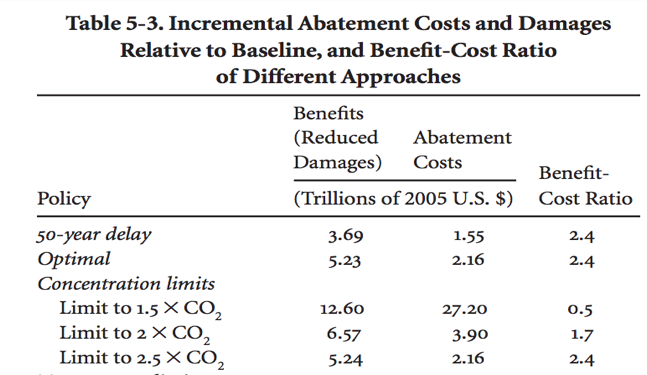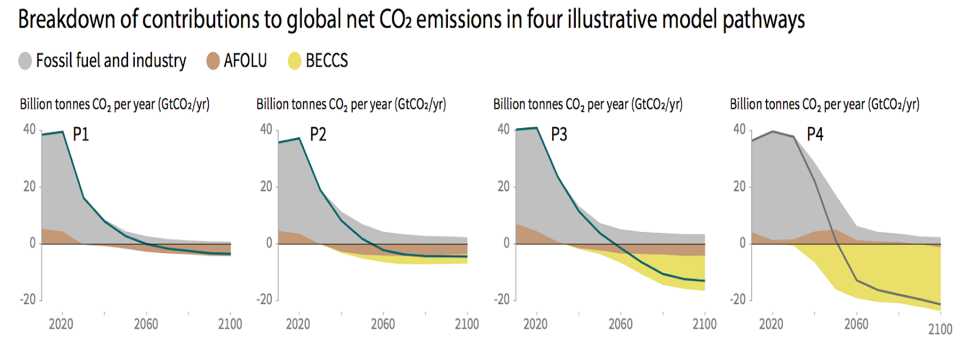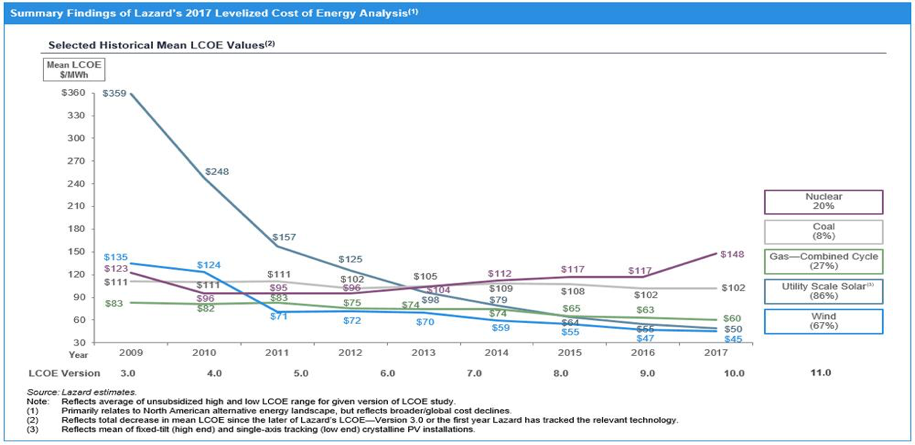In the wake of the IPCC’s new special report on 1.5C, many commentators have argued that such an ambitious climate goal is preposterous and too costly. Several have looked to the work of nobel-laureate William Nordhaus to do so, citing that his modeling of an optimal global carbon tax points to warming of nearly twice the goal assessed in the recent IPCC report. However, if they were to read and understand the entirety of Nordhaus’ work, they might hesitate before reaching this conclusion. Because while it is totally possible to take a skeptical view of the UN’s goals, it’s hard to embrace Nordhaus’ work as a means to reject climate action far more ambitious than anything we have today and—in particular, a carbon tax.
Recent articles by David R. Henderson and Bjorn Lomborg suggest Mr. Nordhaus’ conclusions do not support the recommendations of the new IPCC report that urged for achieving net-zero emissions by 2050. Lomborg argues that Nordhaus’ work is evidence that the “costs of proposed CO2 cuts aren’t worth it,” while Henderson claims that an article by my colleagues Joseph Majkut and David Bookbinder demonstrates that we here at the Niskanen Center have ignored the work of Nordhaus. Not only are these articles by Lomborg and Henderson a disservice to the work Nordhaus has produced for nearly half a century, but they ignore fundamental concepts of environmental economics. It is also worthwhile to point out the factual errors and inconsistencies found in Lomborg’s article in order to present a realistic account of the IPCC special report findings, and the advancements the cleantech industry has made in the last decade.
Optimal Policy: Net-Benefits of Reducing Emissions Today
To use Nordhaus’s findings to argue for no or limited climate action is nonsense. Nordhaus established the foundation of paying today to avoid the worst effects of climate change, as his work clearly demonstrates that there are long-term net benefits for reducing emissions.
A study from Robert Murphy, which Henderson cites in a separate article, uses figures from Nordhaus’ 2008 book titled A Question of Balance to argue that the damages of no controls on global temperature increase are less than the estimated costs associated with limiting temperature increase to 1.5˚C. This is hardly an innovation of Nordhaus’ own work. But Nordhaus also clearly establishes an optimal policy, whereby a carbon tax of $33.8 per ton of CO2 in 2010 would avoid at least $5 trillion in discounted damages, with costs less than half that.

The optimal policy that Nordhaus is suggesting is a tax that would increase incrementally with time, so that by 2025 the carbon tax would be at $53.39 per ton of CO2.
Nordhaus’ optimal policy is far more ambitious than most carbon pricing schemes we’ve seen to date. If Lomborg and Henderson support Nordhaus’ conclusions to discredit the new IPCC report, then they should grapple with his full set of conclusions, including his findings regarding the net-benefits of immediate climate action.
Impacts of Delayed Action
Lomborg’s articles use Nordhaus as a base to argue for delaying climate action, as that will give clean technology enough time to mature and be able to deal with the problem itself instead of “pushing so hard for carbon cuts before alternative energy sources are ready to take over.” Similarly, Henderson has pointed to instances such as the fracking revolution that has reduced emissions to argue the point that stringent climate policy is not necessary.
Delaying climate action is certainly not in line with any of Nordhaus’ conclusions or findings. In fact, Nordhaus’ research shows that there are indeed substantial net benefits from cutting CO2 emission now rather than waiting fifty years. From his 2008 book A Question of Balance, Nordhaus shows that the cost of waiting fifty years to begin reducing CO2 emissions rather than acting immediately is $2.3 trillion in 2005 prices, which in today’s economy is close to $4 trillion dollars. There is clearly no case for delay.
Nordhaus even responded to calls for delayed climate action, saying “waiting is not only economically costly, but will also make the transition much more costly when it eventually takes place.” The article by my colleagues, which prompted Henderson’s criticism, conveys exactly this point by Nordhaus. They argue that had the world listened to his policy prescriptions in the early 90s, the world economy would have been incentivized in a manner that would have rendered the transition to a low-carbon future less costly than it is today. Henderson ignores the fact that the costs of limiting global warming is a function of time, meaning that the costs of limiting warming to 1.5˚C in 1992 are markedly different than the costs of achieving that today. Using Nordhaus as a voice for delayed climate action is another misrepresentation of his work that clearly demonstrates the net-benefits of tackling the problem of rising emissions immediately.
Uncertainty in Climate Models
Both Lomborg and Henderson are trying to make the point that concerted efforts to reduce emissions today are too costly and cannot be economically justified. It has already been demonstrated that Nordhaus’ work, though cautious with regards to too ambitious CO2 reductions, does support emission reductions immediately in order to achieve net-benefits. However, it is noteworthy to mention that the IPCC’s ambition to limit warming to 1.5˚C does not stand in contrast to Nordhaus’ findings.
In A Question for Balance, Nordhaus acknowledges that the models he employs have a limited ability in looking at the potential catastrophic events and climate tipping points “at which damage functions turn up sharply and damages become infinite,” which might “justify trillions of dollars of abatement costs.” Since 2008, the literature relevant to the risks associated with climate change has grown tremendously, and as a result Nordhaus calibrated his models accordingly. His recent assessment found that cost of carbon to address the growing risks of climate change has grown 50 percent since 2013, to over $30 per ton.
Again, in this work, Nordhaus is cognizant that there is a high degree of uncertainty inherent to his Dynamic Integrated Climate Economy (DICE) model, and that “taking uncertainties into account, the strength of policy as measured by the social cost of carbon or the optimal carbon tax would increase, not decrease.” Although Nordhaus’ models do target an “optimal” emission pathway that is not consistent with the pathway suggested by the IPCC, he is well aware of the damage that unmitigated climate change could entail.
Cost of Unmitigated Climate Change and Alternative Technology: Fact vs. Fiction
Lomborg cites the IPCC 2014 assessment in order to stipulate that unmitigated climate change will cost the planet 0.2% and 2% of gross domestic product, concluding that it’s “simply not the end of the world.” However, Lomborg fails to include the rest of the IPCC’s statements that these are incomplete estimates, and that losses are more likely than not to be greater rather than smaller than that range. This is because those estimates do not account for catastrophic changes, tipping points, and many other factors. The IPCC’s most recent report includes the estimated costs for warming of 1.5˚C and 2˚C, which include market and non-market impacts, impacts due to sea level rise, and impacts associated with large scale discontinuities, and found those costs to be $54 and $69 trillion respectively. These figures definitely do not represent a future that is as encouraging as Lomborg would suggest.
Another assertion made by Lomborg is that all use of fossil fuels would need to stop in less than four years in order to achieve the 1.5˚C target. This is simply not true. Nowhere in the IPCC’s special report do they claim that all fossil fuel use would need to stop in the next four years. The IPCC determines that in order to limit global warming to 1.5˚C, global greenhouse gas emissions would need to drop to 45 percent below 2010 levels by 2030 and reach net-zero emissions by 2050.

Source: IPCC Special Report
All the emissions pathways presented by the IPCC show greenhouse gas emissions, and thus fossil fuel use, extending well beyond 4 years, so Lomborg’s assertion is simply incorrect.
Lomborg argues that the focus should not be on cutting carbon emissions, but should rather center around resolving the perceived technology deficit that makes it difficult to move away from fossil fuels because green energy is mostly “uncompetitive.” The notion that alternative energy sources still cannot compete with traditional fossil fuel sources is outdated. The prices of renewables, namely wind and solar have dropped drastically over the last decade.

The figure above found in Lazard’s Levelized Cost of Energy Analysis (LCOE) represents the full lifecycle costs of conventional and alternative energy sources. The LCOE values for alternative technologies continue to decline, and in some cases the full-lifecycle costs of building and operating renewables have dropped below the operational costs alone of traditional fossil fuel sources. Thus, the argument that we should not force carbon cuts until the technology is ready is outdated, and the energy market looks well in place to begin converting to a low-carbon future.
Immediate and Forceful Policy
The approach to climate change presented in Henderson’s articles, and the “wait and invest in R&D” approach advocated for in Lomborg’s piece, are incorrect, dangerous, and most importantly implicitly reject Nordhaus’ views on the issue. To assert that Nordhaus’ findings justify no or tepid action on climate change is an incomplete and simply misinformed picture of an economist who has laid the foundation, as well as the justification for immediate action to curb global emissions. Nordhaus is well aware of the costs on society that climate change will impose, and how uncertainty inherent in estimating these damages means that climate action should be stringent and taken immediately. In his own words, “uncertainties would point to more rather than less forceful policy, and one starting sooner rather than later to slow climate change.”
Photo by Markus Spiske from Pexels.